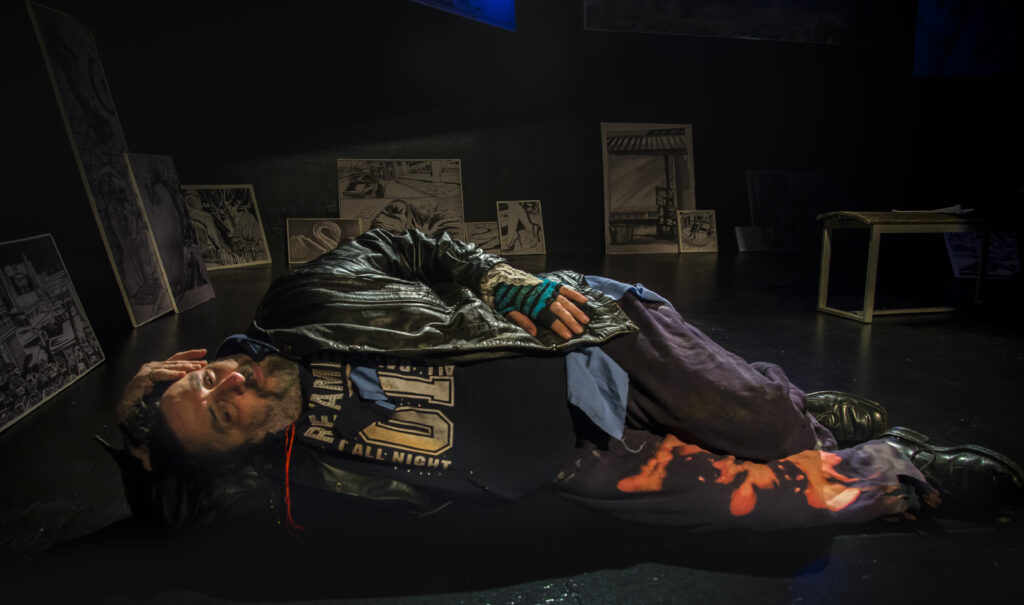When he was in his early 20s, actor and writer Robert Galinsky remembers constantly walking past a group of homeless guys who used to hang out on the steps of the Yale University Art Gallery in New Haven, Connecticut – frequently screaming and yelling at each other. At first, he didn’t pay much attention, but, once he did, their poetic vulgarity drew him in. When he started hanging out with them, he learned they were much more than “the zombies” he originally envisioned. “They were human beings with depth and emotions and relationships, with desires and needs and interesting histories,” Galinksy says.
Those subjects shaped his play, The Bench, A Homeless Love Story. Running at the Conyers Rockdale Council for the Arts Blackbox Theater August 4 to August 6, it’s a one-man show written and performed by Galinsky, based on true stories of five homeless characters and the chaos that ensued when the AIDS crisis hit in the ’80s, affecting one of them.
Galinsky’s first version of The Bench was in 1987, and he continued plugging away with a show called 15 Minutes on a Bench the following year in New Haven with a full cast. In the late ’90s, though, he saw how John Leguizamo had blown up with his one-man show and said to himself the following year, “I can do that.” His revamped solo piece was hatched at The Kitchen in Manhattan, and Galinsky was pleased with audience reaction. By this time, he knew he was onto something and added a female character to the ensemble.
The playwright stuck with the material, and it eventually landed off-Broadway in 2017, directed by actor Jay O. Sanders at the Cherry Lane Theatre and presented by Galinsky’s friend Barry “Shabaka” Henley. Sanders, an entertainment veteran — who has appeared in films such as JFK, The Day After Tomorrow, Glory, Half Nelson and TV series’ such as Sneaky Pete, The Sinner (Season 2), True Detective (Season 1), and The Good Wife — was an immense help.

Sanders’ first connection with Galinsky was to form a friendship. Galinsky had approached Sanders about listening to the work; Sanders found he was quite taken with it. “It was rich material,” says Sanders. “Robert is full of heart and connected to these people.” One piece of advice he passed on was that Galinsky needed to get out of his own way and really fully embrace these people, since he knew them so well. “As Robert experienced the difference, the characters collided and exploded together,” says Sanders. “It’s an exciting thing to watch.”
The play fields five original characters, with Galinsky as the sixth. The subjects include a Vietnam vet; a truck driver with a brain injury; an ex-Merchant Marine who’s the ringleader of the group; a young character who’s a trust fund kid; and the woman they are all attracted to, a former schoolteacher. A lot of the material centers around AIDS — at the time, it was thought to be contagious and a death sentence.
For Sanders, who will not be able to make the trip to Conyers because he is about to start rehearsals for a theater gig, one of the concepts he has taken away from the work is the idea of what is home, when people are spending so much time on Zoom trying to figure out how to connect? “To have people in the same room with someone live in front of you becoming these characters — the DNA of the room is a really important element. These characters are not alone. It’s not a political streetside. It’s simply an appeal to humanity, and that should always be topical.”
He also draws parallels between the ’80s and the current era. “From the AIDS pandemic and to the COVID pandemic, there’s the idea that we can always consider ourselves one step away from a fall from health and a dangerous life,” he said.
The play also spoke to Shelli Siebert, executive director of Conyers Rockdale Council for the Arts. She admitted the organization has not done much yet in terms of presenting live theater, and that was another draw.

“The play speaks to so many issues our communities are facing. We are located 20 miles east of Atlanta, so people think we are not faced with the same issues of a big city — but we are. Homelessness has become a big piece of that. In an alcove area outside the theater, someone is almost always on a bench overnight. Robert does a tremendous job, from what I have seen, making this real and relatable. We wanted to make this one of our very first producing plays.”
Galinsky pointed out how so little has changed since his first draft more than 25 years ago. “When you look through the kaleidoscope of time, people are still wrestling with the same issues — drug addiction, homelessness, [which is] worse than ever and . . . mental illness,” he said. “Those things are part of the problem. The play resonates because not much has changed. I think these things are solvable, but there’s not much will to stop them.”
::
Jim Farmer is the recipient of the 2022 National Arts and Entertainment Journalism Award for Best Theatre Feature and a nominee for Online Journalist of the Year. A member of five national critics’ organizations, he covers theater and film for ArtsATL. A graduate of the University of Georgia, he has written about the arts for 30-plus years. Jim is the festival director of Out on Film, Atlanta’s LGBTQ film festival, and lives in Avondale Estates with his husband, Craig, and dog, Douglas.

